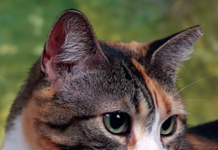As form follows function, all cats are magnificently engineered from the inside out to pursue and capture their prey. The cats hunting style – stealth and lightning sprints with multiple course corrections – owes its success to basic design principles. Like all mammals, the cats skeleton has two functions: It supports the body, allowing movement at specialized areas called joints and provides protection for the internal organs. Individual design components like the spine, the collarbone, and the long, slender bones of the legs and feet contribute to the cats amazing physical capabilities.
Built for agility and beauty
Success in the hunt depends partly on speed. Domestic cats can reach speeds of 30 mph. How do they do this? One unique aspect of the feline skeletal structure is the mobility of the vertebral column, or spine. Abraham Bezuidenhout, DVSc, senior lecturer in the department of biomedical sciences at the Cornell University College of Veterinary Medicine, explains that the articulations (joints) between successive vertebrae allow a greater degree of movement in the cat than in other animals.
Fibroelastic cushioning disks between each vertebra makes a cats spine very flexible. Cats can lengthen their stride, thereby increasing their speed, by alternately extending and flexing the vertebral column. A cats running style can be described as a series of elongated jumps. A cat running at top speed can lengthen its stride to three times the length of its body. Other mammals, including humans, pick up speed the more often their feet make contact with the ground. The flexibility of the cats vertebral column also allows for rapid change in direction as well as the cats most singular ability to right itself in mid-air and land on its feet after a fall. Cats generally have 18 to 20 caudal vertebrae in their tail, which is an extension of the vertebral column. The tail is useful as a balance or counterweight, but the tailless breeds dont seem to miss them.
The forelimbs do not attach directly to the body by bone but are held in place by muscles. A small, rudimentary collarbone is not attached to any other bones and is little more than a thin line of bone lying within a muscle. Thus, the forelimbs enjoy great freedom of movement, allowing the cat to extend fully and retract its forelegs to increase its stride length, as well as to abduct (draw or spread away) and adduct (draw toward) its forelimbs. Cats are masters at squeezing through openings that appear too small for them. How many times have you been greeted by a self-satisfied house cat that you thought was inside the house, not outside on the front porch? The lack of a large, fixed collarbone enables cats to compress their shoulders and disappear Houdini-style into seemingly impossibly small spaces.
Maximum leverage and speed
Literally on their toes, cats have a tiptoe stance. With digitigrade locomotion and a design for speed, cats run and walk on their toes. By contrast, people walk on the soles of their feet. This plantigrade (walking on the sole with heel touching the ground) style of locomotion is best suited for a sustained, long distance effort.
Cats need short bursts of speed to overtake their hapless victims. The design of their legs and feet contributes to their success. The bones of the limbs are long and slender. An exceptionally long rear foot provides a stable platform as the cat launches itself either vertically or horizontally. Bezuidenhout stresses the fact that bone length and the way the muscles attach to the bone give cats maximal leverage for longer strides or for jumping to nine times their own height. Unlike the forelimbs, the hind limbs attach directly to the skeleton at the hip. Hip, knee, and ankle joints are constructed so that lateral movement is limited. These strong joints are made to withstand great force in a forward direction. Fusion of some bones in the wrists provides strength and stability for what might otherwise be a rough landing. The structure and position of the bones in the forearm give cats a limited ability to supinate (rotate the forearm so the palm faces up) and pronate (rotate the forearm so the palm faces out). A cat may move its paws with grace and dexterity, but this movement allows him to capture prey with alacrity.
Cats are splendidly wrought. Because they outperform most other domestic animals in their class (mammalia), our fascination with their grace, athleticism, and beauty never wanes.



